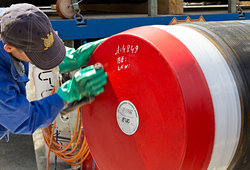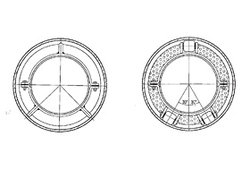FW-Components
The system inside the system
Standard Lengths
are supplied in 12 or 16 metres, measured in terms of the inner pipe. The inner pipe is guided through the encasing pipe on bearings and is 30 cm longer than the encasing pipe.
The inner pipe is continuously heat-insulated with shells of resinoid bonded mineral wool, or if preferred of glass wool or calcium silicate. The exterior of the encasing pipe is provided with passive corrosion protection, consisting of polyethylene as per DIN 30670 N.
Inner and encasing pipe ends are supplied with welding bevels as per DIN 2559. The inner pipe is secured to prevent it from sliding out of the encasing pipe during transport. These securing elements are not removed until the construction unit is lying in its final position in the trench. The red transportation caps prevent dirt and water from entering the pipe. They remain the property of FW- GmbH and are, in general, taken back by the evacuation fitter.
FW STEEL-CASED PIPE-IN-PIPE- elbows
The inner pipe elbows are as per DIN-EN 10253. The required wall thicknesses and construction type are calculated by FW.
The elbows of the encasing pipe are made of cut segments on the basis of the straight lengths. Elbows are mounted to standard or fitted lengths at the factory.
Pipe bearings
Inner pipes with diameters of up to DN 150 are secured by shoe supports, those of larger diameters by roller bearings.
The spacing of the bearings depends on the nominal diameter of the inner pipe.
Inner pipe DN 25 to DN 65 four bearings per 12-metre length
Inner pipe DN 80 to DN 150 three bearings per 12-metre length
Inner pipe DN 200 to DN 1000 two bearings per 12-metre or 16-metre length
FW will determine whether any further bearings - radial bearings for the axial and radial movement of the inner pipe within the encasing pipe, axial bearings for two-pipe systems (only for nominal diameters between DN 25 and DN 125), or roller-bearing cages for transmitting extreme forces to the encasing pipes - are required, and if so, will install them.
Fix points
The position of the anchors determines and controls the direction of the expansion of the inner pipe.
End fix points
consist of a steel disc welded between the inner and the encasing pipe so as to be pressure-tight.
The end fix points also fulfil the function of a vacuum-tight end seal. To be used for temperatures of up to 110°C.
FW STEEL-CASED PIPE-IN-PIPE-anchors up to 200°C
The friction between the encasing pipe and the soil is a multiple of the arising anchor force, so that no concrete foundations are required to dissipate the anchor forces.
FW STEEL-CASED PIPE-IN-PIPE-anchors up to 400°C
In such cases the exterior of the encasing pipe is provided with additional thermal insulation over a length of approx. 2 metres.
FW STEEL-CASED PIPE-IN-PIPE-anchors transmit the forces originating from the inner pipe to the encasing pipe through steel discs that are thermally separated from each other. The encasing pipe disc has openings in it (for air pressure testing and evacuation) and does not form a sealing bulkhead.
FW STEEL-CASED PIPE-IN-PIPE- wall duct
A structure (be it the building where the heat is required, an inspection chamber or the district heating station) and a pipeline connected to it show different settling characteristics. In addition, the steel-in-steel pipe, at a temperature of 20 - 30° C, tries to expand axially. FW STEEL-CASED PIPE-IN-PIPE- wall ducts with lenticular compensators are designed to withstand these forces and remain watertight.
FW STEEL-CASED PIPE-IN-PIPE- axial compensator seal
An axial compensator not incorporating any section of inner or outer pipe is pulled over the continuous inner pipe bearing the medium, and is welded vacuum-tight on the one hand to the inner pipe and on the other to a steel disc mounted on the encasing pipe. In this way, flexible and yet vacuum-tight enclosure of the end of the encasing pipe is brought about.
Axial compensators in FW STEEL-CASED PIPE-IN-PIPE
Axial compensators supplied by well-known manufacturers are installed directly into the FW STEEL-CASED PIPE-IN-PIPE. The compensators are pre-stressed at the factory so that no pre-stressing errors can be made on site. The heat insulation mounted on the compensators is designed so as to ensure adequate insulation whatever the position of the compensator (sliding insulation).
Axial compensators are designed by FW with a safety margin of 20% in terms of the degree of expansion.
On-site connections
All the materials for creating a connection, except the additional welding materials, are supplied by FW (mineral wool insulation, steel bands and crimps to secure it, glass fabric strips as protection during welding, bare steel pipe from which half-shells for the encasing pipe can be cut, shrink material or polyethylene wrapping strips to provide passive corrosive protection for the encasing pipe).
FW's route plans show which on-site connections can be “drawn together” (only one weld in the encasing pipe) and which cannot (two welds in the encasing pipe).
Photos
Photos
-

FW STEEL CHAMBERS being prefabricated
-
Installation FW STEEL CHAMBER at Frankfurt/Main
-

Transport to site of the prefabricated FW-pipes
-

District heating supply Hamburg – very restricted space conditions, FW-SIS 800/160/1400 prefabricated at factory and FW-SIS t-junction 1000/160/1400 and wall duct
-

FW-SIS construction units
-

-

Vacuum-tight axial compensator seal















